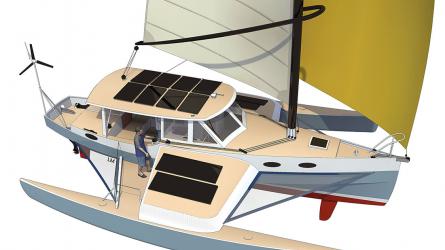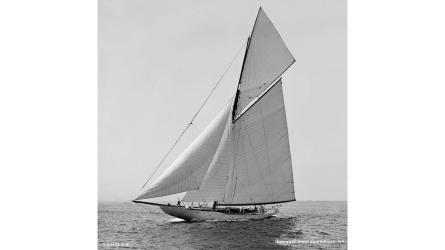The Delivery from Hell—Part Four: Carolina to Georgia
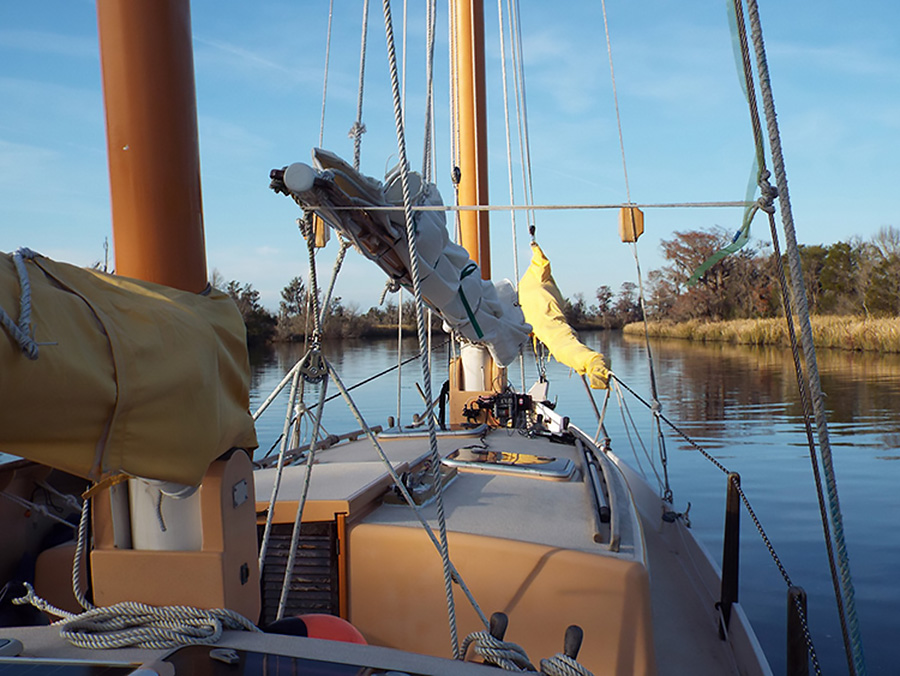
IBIS in the remote creeks and ditches of North Carolina; The sail cover is off the fores’l to keep it handy if needed.
Sunday 11/29 0830—I left the Calabash River and found a fuel dock in Little River. This used to be a small, quiet fishing village, but now it has two huge floating casino ships to take gamblers offshore where it’s legal to separate them from their money the dumbest way possible. And there are high-speed tourist boats, bars and restaurants all along the waterfront. By 1330 I was just past Bucksport, where I wanted to stop for a cheeseburger, but kept going.
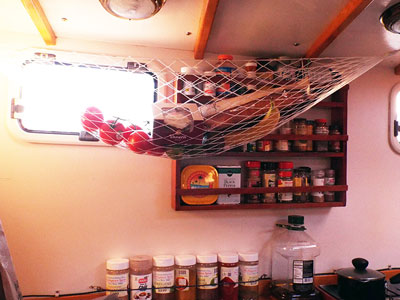
IBIS’s produce net, with goodies from Panera Breads in addition to bananas, limes and tomatoes; You can see by my spices that I am a devoted cook.
Perhaps the worst things about singlehanding in the ICW are dealing with food and body functions. It is important to keep your bowels healthy and regular (using the head every morning before getting under way); and it is wise to prepare your lunch before weighing anchor. Otherwise, you end up engaging the autopilot, running below to take out bread, cheese, sliced meat, lettuce, tomato, mayonnaise, mustard and something to drink (V-8 juice). You do this in stages, poking your head above the hatch every 15 seconds or so to make sure you aren’t about to hit something—and making minor adjustments to your course by pressing the 1-degree buttons on the autopilot. When your sandwich is finally assembled, you rush on deck with it and eat it at the helm. Canned soup is good for lunch on cold days—you put it on the stove, duck down to stir it, and eat it out of the pan standing up. If you have to pee, you wait until no-one can see, and stand at the rail. If it is pouring rain, in violent wind and waves, you pee right into the cockpit scuppers. If you have to poop, you must anchor someplace. Or—you can keep a 5-gallon bucket in the cockpit with a gallon of sea water. You steer sitting on the bucket, drawers around your ankles, merrily waving to the odd powerboat that races past you. Life is good!
Bathing is another matter. This I did at the end of every other day, by heating two quarts of water on the stove, taking them forward to the shower compartment in the night cabin, and dumping saucepans of water over my head while washing with shampoo. Believe me—in 35-degree weather, this is just no fun at all!
A final point to mention is that, for safety backup, I always keep one sail ready to raise quickly, in case of engine failure (see photo above). I have done this all my life—usually the central-most sail (the fores’l on a schooner)—which can work on any point of sail.

I passed this 3-masted steel schooner shortly before anchoring in Jericho Creek.
At 1535 I anchored in Jericho Creek, because the next leg would traverse Winyah Bay, and there was no secure place to anchor there before dark.
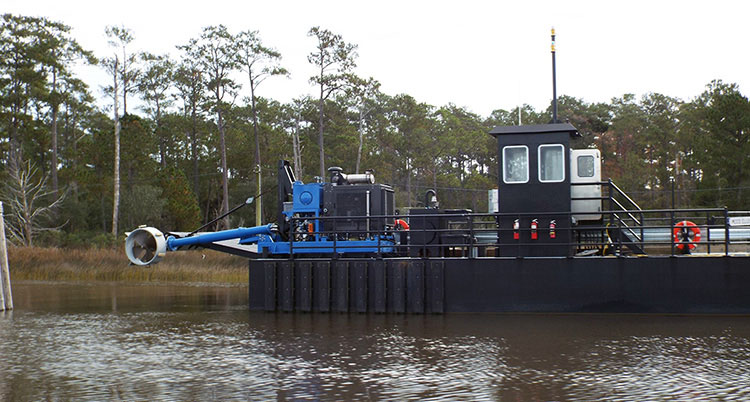
Just inside the ICW canal after Winyah Bay, this unique self-propelled barge acts as a swing bridge.
Black Monday 11/30 0800—I got under way, ran down Winyah Bay, and entered the creeks of South Carolina. This is pretty country, and the ICW is relatively straight, with canals interconnecting miles of coastal creeks and wetlands. By late afternoon I was approaching Charleston, when I ran very hard aground on another shoal that completely blocked the ICW. There were no navigational aids anywhere to warn the unsuspecting mariner, and a small sailboat ahead of me was having similar problems. I tried for hours, until well after dark, and could not get off. The log is full of profanities, and a margin note says “another one of the worst #&^$*% days of my life!” By 2050 the tide and Isuzu finally broke IBIS free, and I anchored in nearby Swinton Creek, close to where I had run aground the first time. I ran aground twice more just trying to find a place to anchor, and with the board only part way down, I was drawing less than five feet. I noted with dismay that the charted aids to navigation were NOT THERE! And the soundings for Swinton Creek were all wrong.
Tuesday 12/01 0755—I weighed anchor and spent the early morning repeatedly running aground in search of a channel in the ICW. The chart indicated that a sand bar protruded from the west bank more than half way across, so I was concentrating my efforts near the east bank. I tried repeatedly to find a way through, only to run aground again and again. I was getting very pissed off. I finally motored a half-mile back to where a dredge was working, and blasted my air horn at them until a bearded weirdo like me came to shout across the water at me to get out of there! I refused to leave until I finally got him to tell me that the only way past the shoal was well to the west of center—exactly where the shoal was charted in my brand-new, up-dated, very-expensive chart book! I went back to try it, and got through finally, bumping along the bottom. Then I ran hard aground again, but got off. I was ready to kill someone!
By 0855 I was stuck waiting for the Ben Sawyer Bridge to open… then the fog descended. Pea soup. Luckily, I am familiar with Charleston Harbor, and I carefully picked my way from buoy to buoy, avoiding the main channels, until I re-entered the ICW beyond the city marina. I love Charleston, and I usually stop and spend a day walking, admiring the colonial architecture, shopping and eating out—but not this time. I wanted to make it to Beaufort, SC, but I was too tired, and I anchored in Rock Creek at 1605… and I really needed a drink! I should mention here that I never drink on a vessel under way, and do not allow my crew to drink… until the anchor is set in a safe harbor.

When weather permits, I unzip IBIS’s dodger windshield for better visibility (and fresh air); on the dashboard are foul-weather gear, binoculars, gloves, wool cap and air-horn.
Wednesday 12/02—I got to Beaufort by 1115, and paid the Big Bucks ($1.85 per foot!) to tie up for a much-needed lay-day in the city marina. I took on fuel and water, got rid of my garbage, went to the post office, and of course it rained all day… so much for the long walk I needed. My pulled muscle was still bothering me, and I was limping. But I did finally get my cheeseburger (unfortunately it was overcooked). I really eat very little red meat—a cheeseburger is a special treat for me—but if it doesn’t bleed when you bite it, it’s overcooked. The marina courtesy car was unavailable until the next morning, when I took it on a re-provisioning expedition.
Thursday 12/03—After shopping, I left the marina at 1030, and while crossing Calibogue Sound, noticed a pair of very raked schooner masts behind a low island over a mile away. Looking through my binoculars, I confirmed that she was indeed one of mine; LEOPARD, my 75-foot LOA pilot schooner, was in South Carolina, back from cruising in the Bahamas. I took the following photo of her using a powerful telephoto lens. LEOPARD was my fourth personal cruising sailboat (see Post #34), and I dearly miss her. I was forced to sell her after I was diagnosed with stage-four cancer in 1998.

LEOPARD in Calibogue Sound, South Carolina, photographed from a mile away.
At 1640 I anchored in St. Augustine Creek, Georgia, and broke out the rum and eggnog (eggnog is possibly the best thing about December). The tide left IBIS aground some time that night, and my rope loop came off the centerboard….
Black Friday 12/04 0700—I got another bight of rope around the centerboard, leading it to IBIS’s electric ATV winch to try to raise it (unsuccessfully). The log says it was “bitter cold again.” A 20- to 25-knot nor’easter was blowing (was the same one chasing me down the whole eastern seaboard?), and the Georgia sounds were a little rough. In places along the Georgia coast, the ICW leads you out several inlets, nearly into the open Atlantic, to avoid dangerous shoals right in the inlets. In a raging nor’easter, this can be profoundly unpleasant. You can look out and see those big Atlantic Graybeards breaking heavily on the bars! I tended to cut corners, assiduously avoiding running too far out the inlets whenever possible. To do this you must watch the currents and play the tides very carefully.
At 1605 I anchored in Shellbuilt Creek, and dragged anchor onto the bank. I weighed anchor—lots of fun alone in 25-knot winds—and found a large piece of scrap metal wrapped around it. I left there and went to anchor in Mary Creek—charted as shallow—and could not find any water less than 20 feet deep. I ran nearly a mile up this creek, but never found shallow water anyplace (the chart showed four feet). This repetitive business of absurdly wrong soundings on newly-updated charts was really pissing me off! The creek was narrow and deep, with the nor’easter blowing across it. This meant anchoring right up against the north bank to avoid swinging into the south bank during the tide change… which is exactly what happened. I woke up in the middle of the night, got IBIS off the bank, and re-anchored. To make matters worse, the rope bight came off the centerboard again, and I had a hell of a time trying to secure it. I was up half the night….
The reason for anchoring in shallow water is to minimize the weight of anchor plus chain that you have to lift vertically, just as the bow is blowing off downwind. (Also you need less scope.) If the anchor is well dug in, you typically have to use the engine to break it free, further complicating matters for the singlehander. I always use a “lizard”—a line led from the mooring bitt, over an anchor roller, through a heavy-duty block shackled to the cutwater chainplate, and ending in a snap-shackle or chain hook. The lizard is hooked onto the chain rode just after the anchor is dropped, and when more chain is paid out, the point of attachment to the boat is shifted from the bow roller (highest point) to the cutwater (lowest point), greatly reducing the amount of rode required to achieve a 5-to-1 scope, and preventing the chain rode from catching on the bobstay, which can keep a light sleeper awake all night.

IBIS’s “lizard” consists of a nylon line with a snap-shackle for the anchor chain (left); and a heavy-duty block shackled to the cutwater (right).
Black Saturday 12/05—I woke to find IBIS’s stern severely aground on the south bank again, and I could not get free. The creek was just too narrow and too deep to allow the correct 5-to-1 scope required for safe anchoring, and the damn tide was running out! Plus it was even colder than ever… back into those stinky long johns! And the weather forecast was for NE winds 20- to 30-knots, with northers to continue all week!
I finally got IBIS floating at 1245, and weighed anchor with difficulty. The challenge in these circumstances is to get the anchor up without being blown back onto the lee bank. I had to engage the autopilot with the diesel at idle, run up to the bow, pull in as much rode as possible as the boat runs over the anchor, run back and shift into neutral, run back to the bow and pull in the slack as the boat falls back, run back to the helm and shift into forward again, run back to the bow and fight with the anchor plus 30 feet of chain being dragged through the mud at three knots! (IBIS goes three knots at dead idle speed….) In the end, you have to pull the anchor up over the roller and secure it there. If the anchor comes up to the roller backwards (facing the wrong way), it is a real bear to pull it up over the roller!
I was NOT having a good time!
At 1550 I anchored in the Frederica River, by St. Simons Island. This was an alternate route to the ICW, a little longer, but protected by higher ground (hammocks instead of nothing but marsh grass). I was next to a small park at Fort Frederica—a historic landmark. I spent two hours trying to secure the centerboard with a second bight of line, also led to the electric winch, but I was unable to raise the board further. I suspected that the broken cable was severely jammed between the board and the trunk. (I learned later that it wasn’t.) I finally gave up and went below to drown my sorrows in Jamaican rum and eggnog.
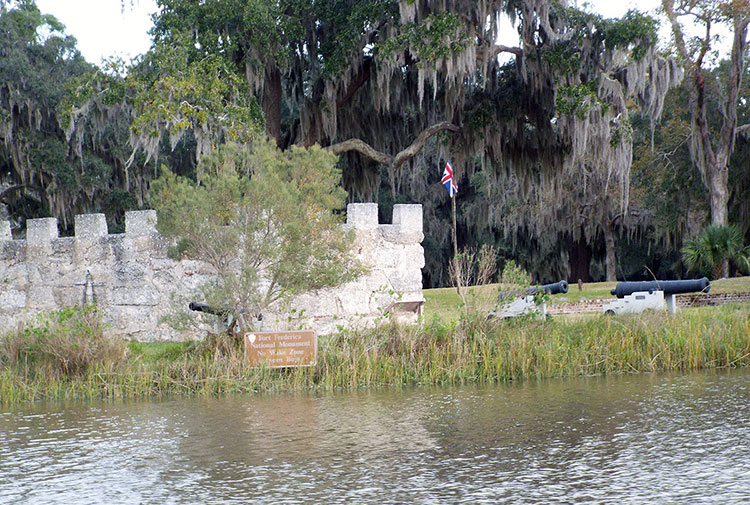
The Fort Frederica National Monument on St. Simons Island, Georgia.
02/11/2016, Saint Lucie Village


